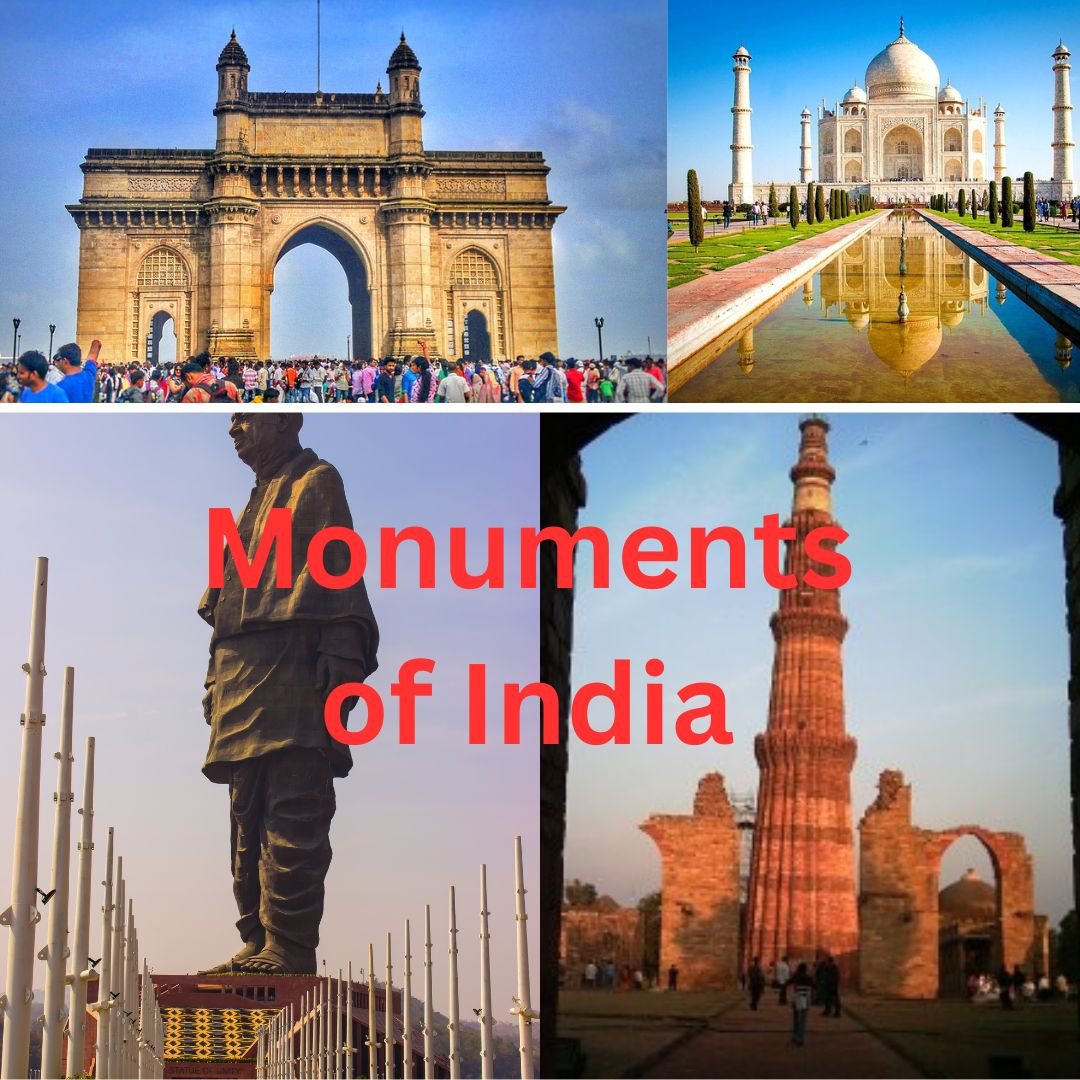Important Monuments of India
India's rich history is reflected in its diverse cultural, architectural, and historical monuments, from ancient rock-cut caves to Mughal and colonial buildings. This carefully curated list of India's Top 50 Monuments, with locations and brief explanations, is a helpful resource for UPSC, SSC, banking, and state civil service applicants. Discover UNESCO World Heritage Sites, majestic forts, sacred temples, and moving memorials while learning general knowledge. Explore India's rich history and improve your exam prep.
| Image | 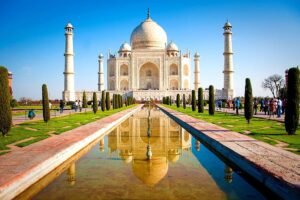 Image Image Credit: Joel Godwin, CC BY-SA 4.0, via Wikimedia Commons Image Image Credit: Joel Godwin, CC BY-SA 4.0, via Wikimedia Commons
|
|---|---|
| Monument | Taj Mahal |
| Location | Agra |
| Explanation | The Taj Mahal is a majestic white marble mausoleum built by Mughal Emperor Shah Jahan in memory of his wife, Mumtaz Mahal. It is renowned globally as an epitome of love and is one of the Seven Wonders of the World. |
| Image | 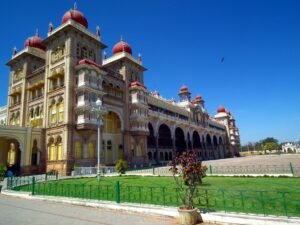 Image Credit: Ramesh NG, CC BY-SA 2.0, via Wikimedia Commons Image Credit: Ramesh NG, CC BY-SA 2.0, via Wikimedia Commons |
|---|---|
| Monument | Mysore Palace |
| Location | Mysore |
| Explanation | Mysore Palace, also known as the Amba Vilas Palace, is a magnificent architectural gem showcasing a stunning blend of Indo-Saracenic and Dravidian architectural styles. |
| Image | 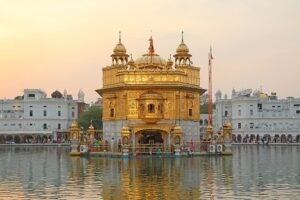 Image Credit: Bernard Gagnon, CC BY-SA 4.0, via Wikimedia Commons Image Credit: Bernard Gagnon, CC BY-SA 4.0, via Wikimedia Commons |
|---|---|
| Monument | Golden Temple |
| Location | Amritsar |
| Explanation | The Golden Temple, also known as Sri Harmandir Sahib, is a prominent Sikh Gurdwara with stunning architecture, the central shrine covered in gold, surrounded by a large serene lake. |
| Image | 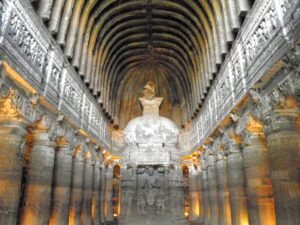 Image Credit: Vasukrishnan57, CC BY-SA 4.0, via Wikimedia Commons Image Credit: Vasukrishnan57, CC BY-SA 4.0, via Wikimedia Commons |
|---|---|
| Monument | Ajanta and Ellora Caves |
| Location | Aurangabad District, Maharastra |
| Explanation | The rock-cut caves containing carvings are the finest example of Indian paintings and sculpture.The Ajanta Caves are 30 rock-cut Buddhist cave monuments dating from the second century BCE to about 480 CE in Aurangabad district of Maharashtra state in India. Ajanta Caves are a UNESCO World Heritage Site. Universally regarded as masterpieces of Buddhist religious art, the caves include paintings and rock-cut sculptures described as among the finest surviving examples of ancient Indian art, particularly expressive paintings that present emotions through gesture, pose and form. |
| Image | 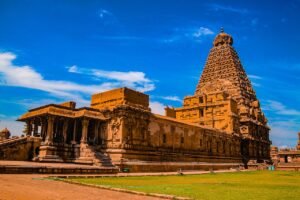 Image Credit: Anupam Mukherjee, CC BY-SA 4.0, via Wikimedia Commons Image Credit: Anupam Mukherjee, CC BY-SA 4.0, via Wikimedia Commons |
|---|---|
| Monument | Brihadeshwara Temple |
| Location | Thanjavur, Tamil Nadu |
| Explanation | Built by Rajaraja Chola I in the 11th century, the temple boasts a towering vimana and is renowned for its intricate carvings, massive lingam, and a monolithic Nandi. |
| Image | 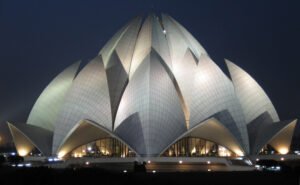 Image Credit: Vandelizer, CC BY 2.0, via Wikimedia Commons Image Credit: Vandelizer, CC BY 2.0, via Wikimedia Commons |
|---|---|
| Monument | Lotus Temple |
| Location | Delhi |
| Explanation | The Lotus Temple is an architectural marvel resembling a lotus flower, symbolizing unity, purity, and peace, constructed using pristine white marble. The Lotus Temple is a Baháʼí House of Worship in Kalkaji, New Delhi, India. It was completed in December 1986. Notable for its lotus-like shape, it has become a prominent attraction in the city. The building is composed of 27 free-standing marble-clad “petals” arranged in clusters of three to form nine sides, with nine doors opening onto a central hall with a height of slightly over 34 metres and a capacity of 1,300 people. |
| Image | 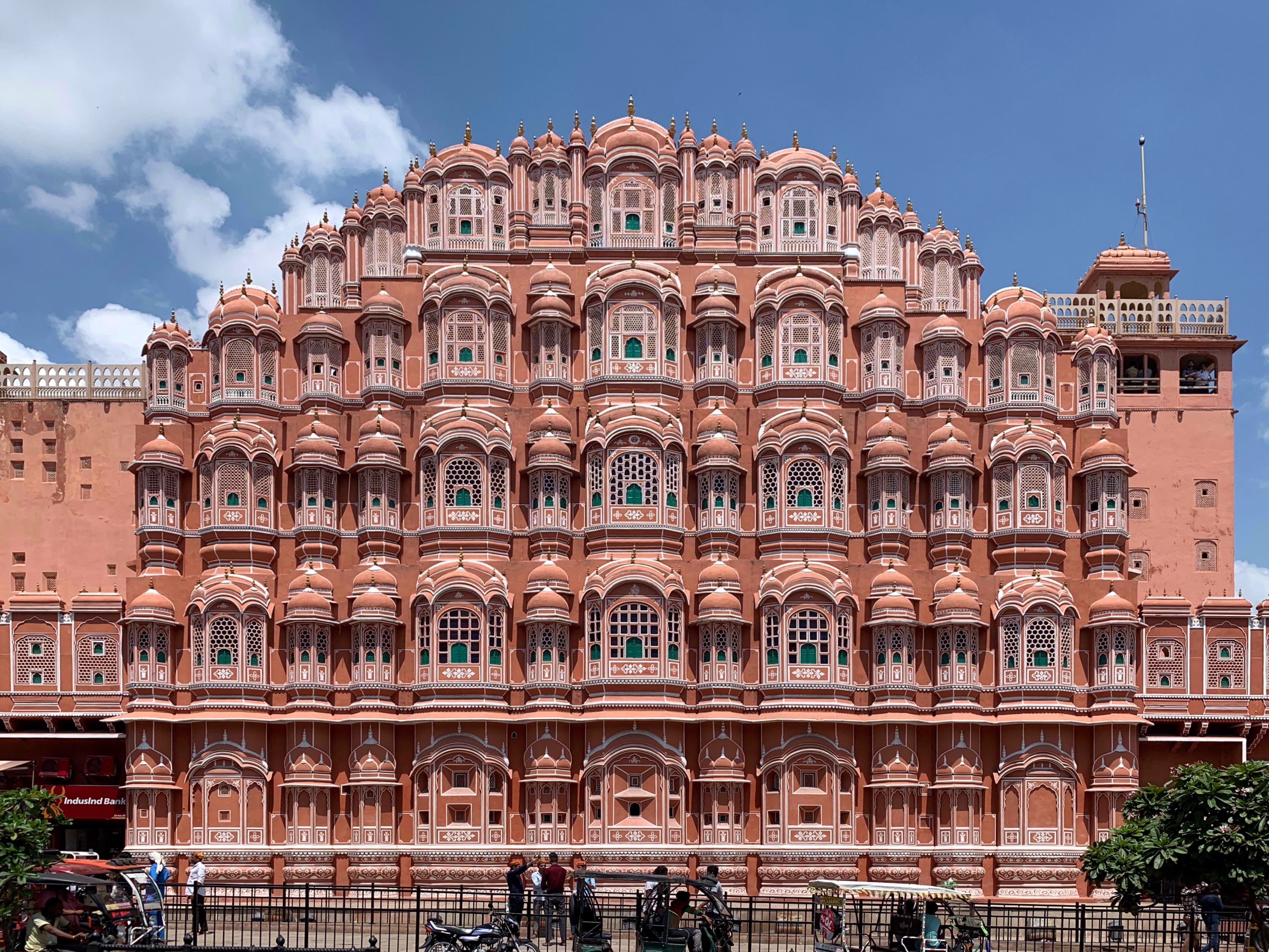 Image source: Chainwit. – Own work, CC BY-SA 4.0, Link Image source: Chainwit. – Own work, CC BY-SA 4.0, Link |
|---|---|
| Monument | Hawa Mahal |
| Location | Jaipur |
| Explanation | Hawa Mahal stands testimony to the rich Rajputana architecture, considered one of the most important and culturally rich historical monuments in India. The Hawa Mahal is a palace in the city of Jaipur, Rajasthan, India. Built from red and pink sandstone, it is on the edge of the City Palace, Jaipur, and extends to the Zenana, or women's chambers.Hawa Mahal also known as the “palace of winds“ built in 1799 by Maharaja Sawai Pratap Singh.It is considered unique as it has many small windows and balconies that seem like a honeycomb |
| Image | 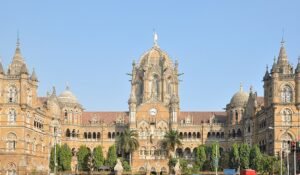 Image Source: Joe Ravi, CC BY-SA 3.0, via Wikimedia Commons Image Source: Joe Ravi, CC BY-SA 3.0, via Wikimedia Commons |
|---|---|
| Monument | Victoria Terminus |
| Location | Mumbai |
| Explaination | Chhatrapati Shivaji Terminus (CST), officially Chhatrapati Shivaji Maharaj Terminus, also known sometimes as Victoria Terminus, is a historic railway terminus and UNESCO World Heritage Site in Mumbai, Maharashtra, India. The terminus was designed by a British architectural engineer Frederick William Stevens from an initial design by Axel Haig, in an exuberant Italian Gothic style. Its construction began in 1878, in a location south of the old Bori Bunder railway station, and was completed in 1887, the year of Queen Victoria's Golden Jubilee. |
| Image | 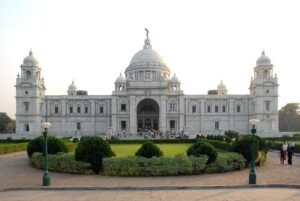 Image source :Joel Godwin, CC BY-SA 4.0, via Wikimedia Commons Image source :Joel Godwin, CC BY-SA 4.0, via Wikimedia Commons |
|---|---|
| Monument | Victoria Memorial |
| Location | Kolkata |
| Explanation | The Victoria Memorial is one of The important monuments of India in Central Kolkata (Calcutta), having its entrance on the Queen's Way. It was built between 1906 and 1921 by the British Raj. It is dedicated to the memory of Queen Victoria, the Empress of India from 1876 to 1901. It stands at 26 hectares (64 acres) of gardens and is now a museum under the control of the Ministry of Culture, Government of India. Possessing prominent features of the Indo-Saracenic architecture |
| Image | 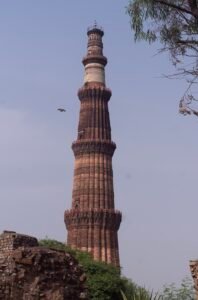 Image Credit:Wasir kasab, CC BY 4.0, via Wikimedia Commons Image Credit:Wasir kasab, CC BY 4.0, via Wikimedia Commons |
|---|---|
| Monument | Qutub Minar |
| Location | Delhi |
| Explanation | The Qutb Minar, is a prominent minaret and victory tower within the Qutb complex, situated at the historic site of Lal Kot—Delhi's earliest fortified city, established by the Tomar Rajputs. Recognized as a UNESCO World Heritage Site in Mehrauli, South Delhi, it was primarily constructed from 1199 to 1220, features 399 steps, and ranks among the city's top tourist attractions. Qutab-ud-din Aibak began building it after conquering Prithviraj Chauhan, the region's last Hindu king, to symbolize the onset of Islamic dominance; he completed only the base level. Later Delhi Sultanate rulers expanded it, with Firuz Shah Tughlaq renovating the upper sections and adding a dome in 1368. It is one of the oldest monuments of India. |
| Image | 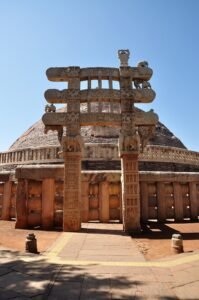 Image credit:CC BY 3.0, Link Image credit:CC BY 3.0, Link |
|---|---|
| Monument | Sanchi Stupa |
| Location | Madhya Pradesh |
| Explanation | Built in the 3rd century, this stupa is a remnant of Sanchi's glorious past and a World Heritage Site, speaking volumes of rich cultural and architectural grandeur. The Sanchi Stupa, featured on the back of India's ₹200 currency note to highlight its cultural significance, is a renowned Buddhist complex atop a hill in Sanchi Town, Raisen District, Madhya Pradesh. Situated about 23 km from Raisen and 46 km northeast of Bhopal, its Great Stupa—among India's oldest stone edifices and a key architectural Monuments of India and was first commissioned by Emperor Ashoka in the 3rd century BCE. |
| Image | 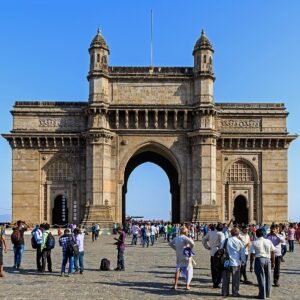 Image credit: A.Savin, FAL, via Wikimedia Commons Image credit: A.Savin, FAL, via Wikimedia Commons |
|---|---|
| Monument | Gateway of India |
| Location | Mumbai |
| Explanation | The Gateway of India is an iconic monument of India symbolizing the city's rich colonial history, constructed to commemorate the visit of King George V and Queen Mary. The Gateway of India, one of the important monuments of India, is an iconic arch-monument completed in 1924 along Mumbai's waterfront. Erected to mark King George V's 1911 landing for his coronation as Emperor of India—the first British monarch to visit—it features an Indo-Saracenic design inspired by 16th-century Gujarati architecture. Architect George Wittet's final plan, approved in 1914 after the 1913 foundation laying, resulted in a 26-meter-high basalt memorial arch resembling triumphal structures and Gujarati styles of the era. |
| Image | 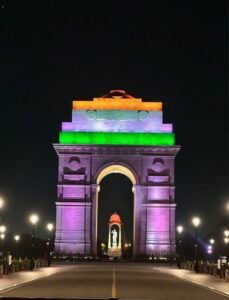
Image Credit: Wikiuser829, CC0, via Wikimedia Commons |
|---|---|
| Monument | India Gate |
| Location | Delhi |
| Explanation | The All India War Memorial is dedicated to the soldiers who died during the First World War and the Third Anglo-Afghan War. India Gate, formerly the All India War Memorial and one of the important monuments of India, is a war memorial situated near Kartavya Path (previously Rajpath) on New Delhi's ceremonial axis. It commemorates 70,000 Indian Army soldiers who died between 1914 and 1921 in World War I across regions like France, Mesopotamia, and East Africa, plus the Third Anglo-Afghan War, with 13,300 names inscribed, including some from the UK. Designed by Sir Edwin Lutyens in a style echoing ancient Roman triumphal arches such as the Arch of Constantine, it's frequently compared to the Arc de Triomphe in Paris and the Gateway of India in Mumbai. |
| Image | 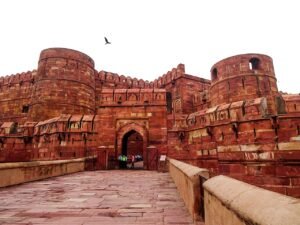 Image credit: Avijitdphy3, CC BY-SA 4.0, via Wikimedia Commons Image credit: Avijitdphy3, CC BY-SA 4.0, via Wikimedia Commons |
|---|---|
| Monument | Agra Fort |
| Location | Agra, UP |
| Explanation | The massive fort of red sandstone by the banks of Yamuna river. Agra Fort, also known as Qila Agra or Agra's Red Fort and one of the important monuments of India, is a historic Mughal fortress in Agra where Emperor Humayun was crowned in 1530. Renovated by Akbar from 1565 to 1573, it served as the primary residence for Mughal rulers until 1638, when the capital shifted to Delhi; it was dubbed Lal-Qila or Qila-i-Akbari. Later occupied by the Marathas before British seizure and further enhanced by Shah Jahan, this walled city—recognized as a UNESCO World Heritage Site in 1983 for its Mughal-era importance—lies about 2.5 km northwest of the Taj Mahal. |
| Image | 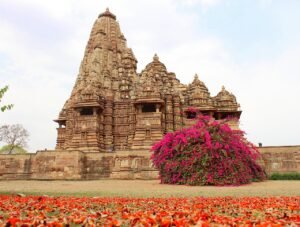 Image Credit: Robin shani, CC BY-SA 4.0, via Wikimedia Commons Image Credit: Robin shani, CC BY-SA 4.0, via Wikimedia Commons |
|---|---|
| Monument | Khajuraho Group of Monuments |
| Location | Madhya Pradesh |
| Explanation | Khajuraho is celebrated for its intricately carved temples that depict various forms, including the renowned Kamasutra, a UNESCO World Heritage site. The Khajuraho Group of Monuments, located in Chhatarpur district, Madhya Pradesh, India, about 46 km from Chhatarpur city, comprises Hindu and Jain temples renowned for their Nagara-style architecture and intricate erotic sculptures. Built by the Chandela dynasty between 885 and 1000 CE, the site originally had 85 temples across 20 square kilometers, with about 25 surviving over six square kilometers. The Kandariya Mahadeva Temple stands out for its detailed sculptures and ancient Indian artistry. Rediscovered in 1838 by British engineer T.S. Burt, the temples reflect a historical acceptance of Hindu and Jain traditions and were designated a UNESCO World Heritage Site in 1986 for their architectural brilliance and cultural significance. |
| Image | 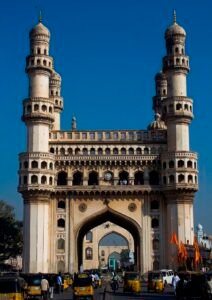 Image credit: By DidierTais – Own work, CC BY-SA 3.0, Link: Image credit: By DidierTais – Own work, CC BY-SA 3.0, Link: |
|---|---|
| Monument | Charminar |
| Location | Hyderabad, Telangana |
| Explanation | The Charminar, meaning “four minarets,” is one of the historic monuments of India in Hyderabad, Telangana, built in 1591, By The fifth ruler of the Qutb Shahi dynasty, Muhammad Quli Qutb Shah, after shifting his capital from Golconda to the newly formed city of Hyderabad. A defining symbol of Hyderabad, featured in Telangana's emblem, it houses a mosque on its top floor, operational for over 434 years. Renowned for its architectural and historical significance, it attracts tourists with its vibrant surrounding markets and proximity to makkah Masjid. Located on the Musi River’s east bank, near Laad Bazaar and the ornate Makkah Masjid. |
| Image | 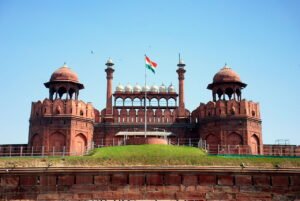 Image Credit: Achyutmisra, CC BY-SA 3.0, via Wikimedia Commons Image Credit: Achyutmisra, CC BY-SA 3.0, via Wikimedia Commons |
|---|---|
| Monument | Red Fort |
| Location | Delhi |
| Explanation | Red Fort, or Lal Qila, is a historic Mughal fort in Delhi, India, built by Emperor Shah Jahan in 1639 as the Mughal capital shifted from Agra. Designed by Ustad Ahmad Lahori, it blends Persian and Indian architectural styles, showcasing the zenith of Mughal architecture. Plundered during Nadir Shah’s 1739 invasion and damaged after the 1857 Rebellion, its defensive walls endured. Since 1947, India’s Prime Minister host the national flag at Lahori Gate on Independence Day. Designated a UNESCO World Heritage Site in 2007, it remains a symbol of India’s heritage. |
| Image | 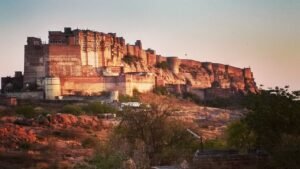 Image Credit:Alvin Antony 910, CC BY-SA 4.0, via Wikimedia Commons Image Credit:Alvin Antony 910, CC BY-SA 4.0, via Wikimedia Commons |
|---|---|
| Monument | Mehrangarh Fort |
| Location | Jodhpur |
| Explanation | Among the largest fortifications in India, its clifftop location showcases Rajasthan’s royal legacy.Mehrangarh Fort, founded in 1459 by Rao Jodha in Jodhpur, Rajasthan, is a grand hilltop fortress spanning 1,200 acres. Expanded in the 17th century, it features seven gates, including Jai Pol and Fatehpol, marking Rajput victories. Its palaces, like Sheesh Mahal, showcase intricate carvings, while the museum holds artifacts like Akbar’s sword |
| Image | 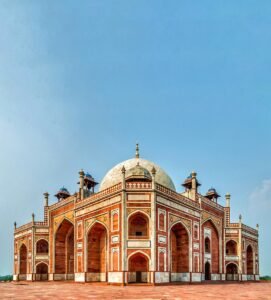 Image Credit: Himeshrahi, CC BY-SA 4.0, via Wikimedia Commons Image Credit: Himeshrahi, CC BY-SA 4.0, via Wikimedia Commons |
|---|---|
| Monument | Humayun’s Tomb |
| Location | Delhi |
| Explanation | The final resting place of Emperor Humayun, this tomb exemplifies Persian architecture with gardens and water features. Humayun’s Tomb, situated near the intersection of Mathura and Lodhi Roads in Delhi, is a grand garden tomb and a pioneering example of Mughal architecture in India. Commissioned in 1565 by Bega Begam, nine years after Emperor Humayun’s death, it features a symmetrical chaharbagh layout with pathways, water channels, and a central double-domed mausoleum. The walled complex houses several Mughal rulers’ graves and was the site where Bahadur Shah II, the last Mughal emperor, was captured in 1857. |
| Image | 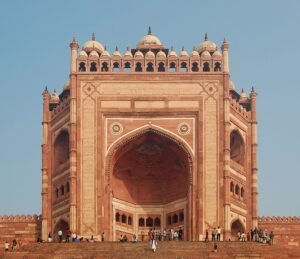 Image Credit: Marcin Białek – Own work, CC BY-SA 3.0, Link Image Credit: Marcin Białek – Own work, CC BY-SA 3.0, Link |
|---|---|
| Monument | Fatehpur Sikri |
| Location | Agra |
| Explanation | Known as the ‘City of Victory,’ it was the Mughal capital for 10 years, with the complex in excellent condition. 37 kms from Agra is built a city predominantly in Red Sandstone and is called Fatehpur Sikri. This town was built by the Mughal Emperor, Akbar. He had planned this city as his capital but shortage of water compelled him to abandon the city. After this within 20 years, the capital of Mughals was shifted to Lahore. Fatehpur Sikri was built during 1571 and 1585. This deserted city has retained many of the old structures, because of the efforts of the Archaeological department. Fatehpur Sikri is the best example of the culmination of Hindu and Muslim architecture. Fatehpur Sikri Mosque is said to be a copy of the mosque in Mecca and has designs, derived from the Persian & Hindu architecture. |
| Image | 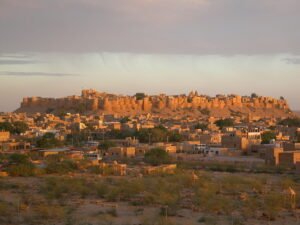 Image Credit: Const.crist, CC BY-SA 3.0, via Wikimedia Commons Image Credit: Const.crist, CC BY-SA 3.0, via Wikimedia Commons |
|---|---|
| Monument | Jaisalmer Fort |
| Location | Jaisalmer, Rajashthan |
| Explanation | Located on the edge of the Thar Desert, its sandstone edifice rises like a mirage above the ‘Golden City.’Jaisalmer Fort, in Jaisalmer, Rajasthan, India, is Rajasthan's second-oldest fort, constructed in 1156 AD by Rawal Jaisal and named after him. Recognized as a UNESCO World Heritage Site in 2013 during the 37th session in Phnom Penh, Cambodia, as part of the Hill Forts of Rajasthan group, it is a rare “living fort” where about one-fourth of the old city's population still lives. For most of its 860-year history, the fort was the city itself, situated at major trade crossroads including the ancient Silk Road, with outside settlements beginning in the 17th century due to population expansion. |
| Image | 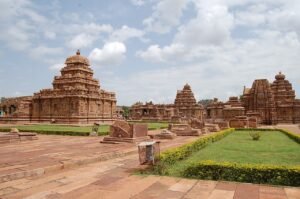 Image Credit: Nithin bolar k, CC BY-SA 3.0, via Wikimedia Commons Image Credit: Nithin bolar k, CC BY-SA 3.0, via Wikimedia Commons |
|---|---|
| Monument | Pattadakal Group of Monuments |
| Location | Karnataka, Bijapur district |
| Explanation | Pattadakal Group of Monuments – Located in Bagalkot district, Karnataka, this UNESCO World Heritage Site (1987) comprises 7th–8th century CE Hindu and Jain temples built by the Chalukya dynasty. Situated on the west bank of the Malaprabha River, it lies close to Badami and Aihole.The site blends northern and southern Indian architectural styles and was historically used for royal coronations. Most temples are dedicated to Lord Shiva, with themes from Hindu epics like the Ramayana, Mahabharata, and Bhagavata Purana, alongside a single Jain temple.Notable structures include the Virupaksha Temple (still active for worship) and Papanatha Temple, both famed for intricate friezes and a rich mix of styles. The site is protected and maintained by the Archaeological Survey of India. |
| Image | 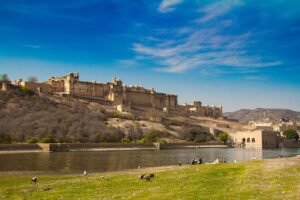 Image Credit: Srshiva2, CC BY-SA 4.0, via Wikimedia Commons Image Credit: Srshiva2, CC BY-SA 4.0, via Wikimedia Commons |
|---|---|
| Monument | Amber Fort |
| Location | Jaipur, Rajasthan |
| Explanation | Divided into four main sections, it contains a palace complex, temples, and courtyards.Amer Fort, also called Amber Fort, is located in Amer, Rajasthan, about 11km from Jaipur. Built on a hill overlooking Maota Lake, it is Jaipur’s main tourist attraction and is noted for its artistic architectural features. The fort was originally constructed by Raja Man Singh and later expanded by Jai Singh I in the early 1600s, with further additions made over the next 150 years. Amer, once known as Dhundar, was the capital of the Kachwaha rulers from 1037 until 1727 when the capital shifted to Jaipur. The history of Amer Fort is closely tied to the legacy of the Kachwaha dynasty. |
| Image | 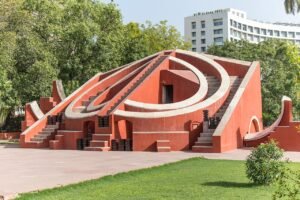 Image Credit: Alessio, CC BY-SA 4.0, via Wikimedia Commons Image Credit: Alessio, CC BY-SA 4.0, via Wikimedia Commons |
|---|---|
| Monument | Jantar Mantar |
| Location | Jaipur, Rajasthan |
| Explanation | Jantar Mantar in Jaipur is one of the world's oldest and largest stone observatories, famous for housing the largest stone sundial, the Vrihat Samrat Yantra. Built by Rajput king Sawai Jai Singh II in 1734, it features 19 architectural instruments designed to measure celestial positions and calculate local time with the naked eye. The monument showcases a unique blend of architectural innovation and scientific precision from the 18th century, reflecting the scholarly interests of Maharaja Jai Singh II in astronomy. Recognized as a UNESCO World Heritage Site, it attracts tourists, historians, and scientists alike..Jantar Mantar is managed under the Archeological Sites and Monuments Act of Rajasthan since 1961, and protected as a National Monument of Rajasthan since 1968. |
| Image | 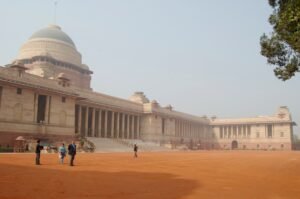 Image Credit: Scott Dexter from Brooklyn, USA, CC BY-SA 2.0, via Wikimedia Commons Image Credit: Scott Dexter from Brooklyn, USA, CC BY-SA 2.0, via Wikimedia Commons |
|---|---|
| Monument | Lutyens’ Delhi |
| Location | Delhi |
| Explanation | Designed by British architect Edward Lutyens, it hosts neoclassical buildings and government functionaries. Lutyens' Delhi is a district in New Delhi, India, named after the British architect Edwin Lutyens (1869–1944), who was responsible for designing most of the city's architecture during the British Raj. The area developed gradually between 1912 and 1931 and includes the Lutyens Bungalow Zone (LBZ). Lutyens designed four bungalows within the Viceroy House Estate, now known as the Rashtrapati Bhavan Estate, located on what is today Mother Teresa Crescent (formerly Willingdon Crescent) |
| Image | 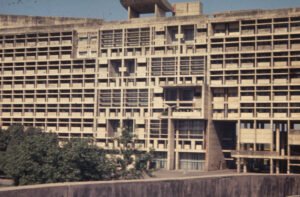 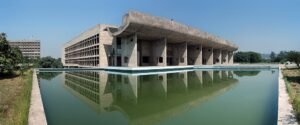
Image credit: Nicholas.iyadurai, CC BY-SA 4.0 |
|---|---|
| Monument | Chandigarh Capitol Complex |
| Location | Chandigarh |
| Explanation | The Chandigarh Capitol Complex, located in Sector 1 of Chandigarh city, India, is a government compound designed by architect Le Corbusier and his team and is recognized as a UNESCO World Heritage Site. Covering an area of approximately 100 hectares (0.39 square miles), it stands as a prominent example of Chandigarh's architectural style. The complex consists of three buildings—the Palace of Assembly or Legislative Assembly, Secretariat Building, and the High Court—along with four monuments: the Open Hand Monument, Geometric Hill, Tower of Shadows, and the Martyrs Monument, plus a lake. In 2016, it was inscribed on the UNESCO World Heritage List |
| Image |  Image Credit:Meesanjay – Own work, CC BY-SA 3.0, Link Image Credit:Meesanjay – Own work, CC BY-SA 3.0, Link |
|---|---|
| Monument | Gol Gumbaz |
| Location | Bijapur, a city in Karnataka |
| Explanation |
Gol Gumbaz, meaning “Round Dome” is a grand 17th-century mausoleum in Vijayapura (formerly Bijapur), Karnataka, India, serving as the tomb for Muhammad Adil Shah, the seventh sultan of the Adil Shahi dynasty, and some relatives; begun in the mid-17th century toward the end of his reign (1627–1656), construction halted unfinished upon his death that year, positioned behind Sufi saint Hashim Pir's dargah to reflect their close bond as observed by historian Richard Eaton. Distinguished by its massive scale, enormous dome, and Adil Shahi architectural style, it was added to UNESCO's tentative World Heritage list in 2014 as part of the “Monuments and Forts of the Deccan Sultanate. |
| Image | 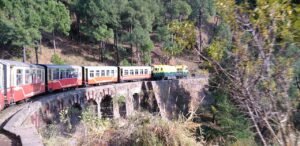 Image Credit: Joyson92, CC BY-SA 4.0, via Wikimedia Commons Image Credit: Joyson92, CC BY-SA 4.0, via Wikimedia Commons |
|---|---|
| Monument | Kalka-Shimla Railway |
| Location | Shimla |
| Explanation | The Kalka-Shimla Railway, one of the important monuments of India, is a 762 mm narrow-gauge line in North India, winding through mountainous terrain from Kalka to Shimla with breathtaking hill and village vistas. Constructed from 1898 to 1903 under Herbert Septimus Harington's supervision to link Shimla—the British Raj's summer capital—to the broader Indian rail network, it initially used locomotives from Sharp, Stewart and Company, later adding larger Hunslet Engine models, with diesel and diesel-hydraulic versions introduced in 1955 and 1970. UNESCO designated it a World Heritage Site in 2008 as part of India's mountain railways. |
| Image | 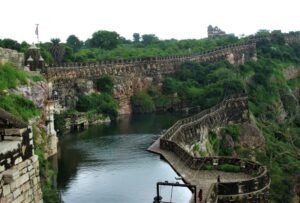 |
|---|---|
| Monument | Chittorgarh Fort |
| Location | Rajasthan |
| Explanation | Chittorgarh is home to the Chittor Fort, one of the largest forts in India and Asia. It was sacked thrice; first in 1303 by Alauddin Khalji, again in 1535 by Bahadur Shah of Gujarat, and lastly by the Mughal Emperor Akbar in 1568. Chittor has been a land of worship for Meera. It is also known for Panna Dai and Rani Padmini. it is one of the important monuments of india. |
| Image | 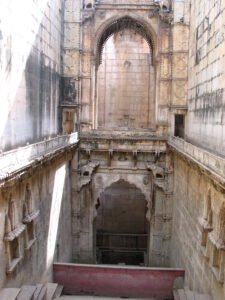 Image Credit:Shakti, CC BY-SA 3.0, via Wikimedia Commons Image Credit:Shakti, CC BY-SA 3.0, via Wikimedia Commons |
|---|---|
| Monument | Bundi Stepwells |
| Location | Bundi, Rajasthan |
| Explanation | Bundi's Stepwell, known as Rani Ji Ki Baori, is a stunning example of intricately carved subterranean water architecture that once served as a vital irrigation source. Constructed in the 17th century by Rani Nathavati Ji, the younger queen of Rao Raja Anirudh Singh of Bundi, the stepwell is adorned with exquisite carvings and sculptures carefully chosen by the queen. Featuring a grand flight of stairs leading down to a water tank that historically supplied the local community, this architectural marvel is now a celebrated tourist destination offering a glimpse into Bundi's rich cultural heritage. Renowned among the important monuments of India, Rani Ji Ki Baori showcases the opulence of the Rajputana era |
| Image | 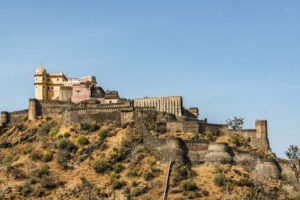 Image credit: Rajesh Kapoor – Own work, CC BY-SA 4.0, Link Image credit: Rajesh Kapoor – Own work, CC BY-SA 4.0, Link |
|---|---|
| Monument | Kumbhalgarh Fort |
| Location | Rajasthan |
| Explanation | Nestled amidst the Aravalli Mountains, the 15th-century Kumbhalgarh Fort features palaces and gardens, and is famed for having the world's second-longest wall after the Great Wall of China. Located 84 kilometres north of Udaipur, this majestic fort is set within a picturesque wilderness and holds the distinction of being a UNESCO World Heritage site. Built during the 15th century by Rana Kumbha, Kumbhalgarh is regarded as the second most significant citadel in the Mewar region, after the renowned Chittorgarh Fort. It is counted among the one of the important monuments of India. |
| Image | 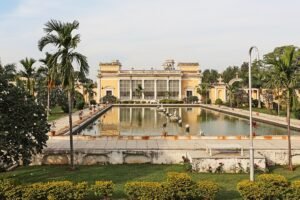 Image Credit: Bernard Gagnon – Own work, CC BY-SA 3.0, Link Image Credit: Bernard Gagnon – Own work, CC BY-SA 3.0, Link |
|---|---|
| Monument | Chowmahalla Palace |
| Location | Hyderabad |
| Explanation | A testament to the ruling Nizam Dynasty, with pretty courtyards and opulent halls. Chowmahalla Palace, named for its four grand palaces, is a magnificent monument in the city reflecting timeless grandeur. Construction began in 1750 under Nizam Salabhat Jung and was completed between 1857 and 1869 by Nizam Afzar-ud-Dawla Bahadur. Originally spanning 45 acres from Laad Bazaar to Aspan Chowk Road, the palace complex is modeled after the Shah’s Palace in Tehran, Iran. Today, it features two courtyards with elegant palaces, including the grand Durbar Hall (Khilwat), gardens, and fountains. The Southern Courtyard is the oldest, housing four palaces—Tahniyat Mahal, Mahtab Mahal, Afzal Mahal, and Aftab Maha |
| Image |  Image Credit:Bernard Gagnon – Own work, CC BY-SA 3.0, Link Image Credit:Bernard Gagnon – Own work, CC BY-SA 3.0, Link |
|---|---|
| Monument | Falaknuma Palace |
| Location | Hyderabad |
| Explanation | Falaknuma Palace, located in Hyderabad, Telangana, is a former royal palace now operating as a luxury hotel. Originally owned by the Paigah family and later by the Nizam of Hyderabad, it is situated on a hillock spanning 13 hectares, about 5 kilometers from Charminar. Built by Nawab Sir Viqar-ul-Umra. the palace’s name means “Like the Sky” or “Mirror of the Sky” in Urdu. Completed in 1893, it was the tallest building in Hyderabad at that time. After extensive renovations completed in 2010, it became part of the Taj Group and is now known as the Taj Falaknuma Palace. It showcases a blend of Italian and Tudor styles, with features like Italian marble, stained-glass windows, and opulent interiors. |
| Image | 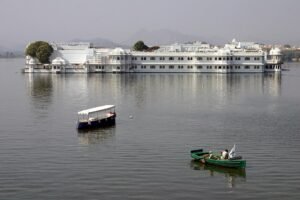 Image credit: Flicka – Own work, CC BY-SA 3.0, Link Image credit: Flicka – Own work, CC BY-SA 3.0, Link |
|---|---|
| Monument | Lake Palace |
| Location | Udaipur, Rajasthan |
| Explanation | The Lake Palace, originally known as Jag Niwas Palace, was once a summer retreat for the royal family of Mewar and is now operated as a luxury hotel. Situated on the island of Jag Niwas in Lake Pichola, Udaipur, India, the palace sits on a natural foundation covering four acres. The original Jag Niwas palace and Lake Pichola were constructed in 1362 AD by Rana Lakshasimha (Laakha) of the Parmar Rajput clan. The current Lake Palace was rebuilt between 1743 and 1746 under Maharana Jagat Singh II, the 62nd ruler of Mewar, who intended it as a summer residence. Initially, the palace was named Jagniwas or Jan Niwas after its founder. |
| Image | 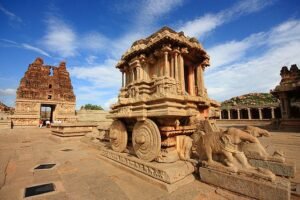 Image credit: Joel Godwin, CC BY-SA 4.0, via Wikimedia Commons Image credit: Joel Godwin, CC BY-SA 4.0, via Wikimedia Commons |
|---|---|
| Monument | Hampi |
| Location | Karnataka |
| Explanation | The ruins of an ancient city, a UNESCO World Heritage site with temples and palaces.Hampi served as the capital of the Vijayanagara Empire from 1336 until its destruction in 1565. It was a fortified, prosperous city along the Tungabhadra River, renowned for its wealth and grandeur, and by 1500 was likely the world’s second-largest city after Beijing. After the empire’s defeat by a coalition of Muslim sultanates and the city’s subsequent destruction, Hampi was abandoned and left in ruins. Today, Hampi’s extensive remains—including temples, palaces, markets, water structures, and more—cover around 4,100 hectares in Karnataka and are recognized by UNESCO as an “austere, grandiose site” representing the last great Hindu kingdom of South India. |
| Image | 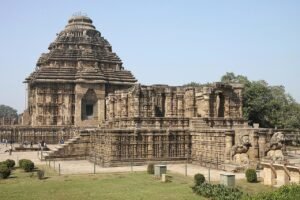 Image Credit: রবিরশ্মি রায়, CC BY-SA 4.0, via Wikimedia Commons Image Credit: রবিরশ্মি রায়, CC BY-SA 4.0, via Wikimedia Commons |
|---|---|
| Monument | Konark Sun Temple |
| Location | Odisha |
| Explanation | The Sun Temple of Konark, located around 35 kilometres northeast of Puri on Odisha's coast, is an extraordinary example of ancient Indian architecture and devotion. Built in the form of a monumental chariot dedicated to the Sun God Surya, the temple features massive stone wheels and detailed carvings that seem ready to spring to life. Recognized as a UNESCO World Heritage site, Konark is renowned for its artistic symbolism and elaborate sculptures. Originally soaring to about 227 feet, much of its main spire is lost to history, but the remaining assembly hall (Jagamohana) and dance hall (Natya Mandap) still showcase stunning craftsmanship. The temple’s unique design is said to channel the first rays of sunlight directly into its sanctum, illuminating the deity with the dawn’s glow. |
| Image | 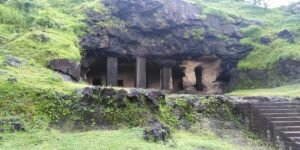 Image Credit:Waseemandbiomes, CC BY-SA 4.0, via Wikimedia Commons Image Credit:Waseemandbiomes, CC BY-SA 4.0, via Wikimedia Commons |
|---|---|
| Monument | Elephanta Caves |
| Location | Mumbai |
| Explanation | The Elephanta Caves, dating back to around the 6th century AD during the Gupta dynasty, were carved primarily as Hindu temples dedicated to Lord Shiva. Believed to have been constructed between the 5th and 8th centuries, Elephanta Island—historically known as Gharapuri—has long been a significant cultural and religious site. The caves, carved into the basalt hills near Mumbai. The most notable is Cave 1, dedicated to Shiva, which features the famous colossal Trimurti sculpture representing Shiva’s three forms as Creator, Preserver, and Destroyer, showcasing a remarkable example of ancient Indian artistry. |
| Image | 
Image Credit:Amitabha Gupta, CC BY 4.0, via Wikimedia Commons |
|---|---|
| Monument | Mahabodhi Temple |
| Location | Bodh Gaya, Bihar |
| Explanation | The Mahabodhi Temple “Great Awakening Temple, a UNESCO World Heritage Site, is an ancient, but restored Buddhist temple in Bodh Gaya, Bihar, India, marking the location where the Buddha is said to have attained enlightenment. Bodh Gaya is 15 km from Gaya and is about 96 km (60 mi) from Patna. The site contains a tree believed to be a descendant of the Bodhi Tree under which the Buddha gained enlightenment and has been a major pilgrimage destination of Buddhists for over two thousand years. The Mahabodhi Temple at Bodh Gaya is the holiest and most revered pilgrimage site for Buddhists worldwide. |
| Image | 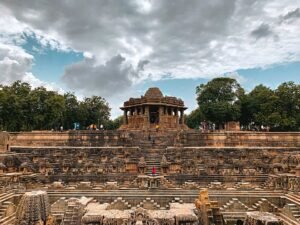 Image Credit:Musafir kanya – Own work, CC BY-SA 4.0, Link Image Credit:Musafir kanya – Own work, CC BY-SA 4.0, Link |
|---|---|
| Monument | Sun Temple |
| Location | Modhera, Gujrat |
| Explanation | The Sun Temple of Modhera one of the important monuments of india, located in the village of Modhera in Gujarat’s Mehsana district, is a Hindu temple dedicated to god Surya. Positioned on the banks of the Pushpavati River, it was constructed around 1026-27 CE during the rule of Bhima I of the Chaulukya dynasty. it is a protected monument managed by the Archaeological Survey of India. The temple complex consists of three main parts: the Gūḍhamanḍapa (shrine hall), the Sabhamanḍapa (assembly hall), and the Kunḍa (reservoir) |
| Image | 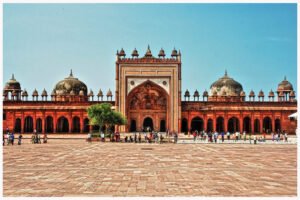
|
|---|---|
| Monument | Jama Masjid |
| Location | Delhi |
| Explanation | Jama Masjid, also known as Masjid-i Jahān Numā, is a prominent mosque in Delhi, India, known for its grand scale and Mughal architectural style. Located in the heart of Old Delhi, it was built by Mughal Emperor Shah Jahan between 1650 and 1656. the mosque is counted among the most important monuments of India, attracting both devotees and architecture lovers throughout the year, as well as a popular tourist attraction. |
| Image | 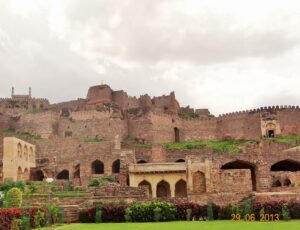 Image Credit: Manish Maryada, CC BY-SA 3.0, via Wikimedia Commons Image Credit: Manish Maryada, CC BY-SA 3.0, via Wikimedia Commons |
|---|---|
| Monument | Golconda Fort |
| Location | Hyderabad |
| Explanation | Famous for its acoustics and diamond mines like Koh-i-Noor. Golconda Fort, situated in the western part of Hyderabad about 9 kilometers from Hussain Sagar Lake, spans an area of three square kilometers with a perimeter of 4.8 kilometers. Originally called Mankal, it was constructed as a mud fort in 1143 under the rule of the Warangal Raja. The fort was later strengthened and expanded from the 14th to the 17th century by the Bahmani Sultans and the Qutub Shahi dynasty, who made Golconda their primary capital. Inside the fort are the remains of palaces, mosques, and a hilltop pavilion that rises approximately 130 meters. earning its place among one of the most iconic monuments of India for its historical importance. |
| Image | 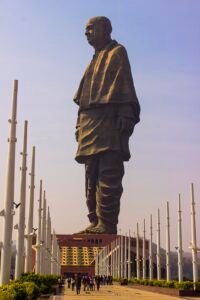 Image Credit: Snehrashmi, CC BY-SA 4.0, via Wikimedia Commons Image Credit: Snehrashmi, CC BY-SA 4.0, via Wikimedia Commons |
|---|---|
| Monument | Statue of Unity |
| Location | Gujarat |
| Explanation | The Statue of Unity is the tallest statue in the world, standing at 182 meters, and is located in the Narmada valley near Kevadia, Gujarat, India. It pays tribute to Sardar Vallabhbhai Patel, India’s first Deputy Prime Minister and Home Minister. The monument is positioned on the Narmada River, facing the Sardar Sarovar Dam and approximately 100 kilometers southeast of Vadodara.The project was first announced in 2010 by Narendra Modi, who was then the Chief Minister of Gujarat. Construction began in October 2013 under the Indian engineering company Larsen & Toubro, with a total cost of ₹27 billion (US$422 million). Renowned Indian sculptor Ram V. Sutar designed the statue. It was inaugurated by Modi—by then the Prime Minister of India—on 31 October 2018, which was Sardar Patel’s 143rd birthday. |
| Image | 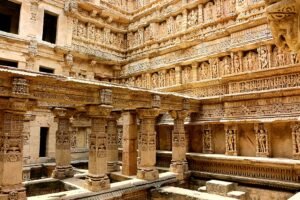 Image Credit:<Rupeshsarkar, CC BY-SA 4.0, via Wikimedia Commons Image Credit:<Rupeshsarkar, CC BY-SA 4.0, via Wikimedia Commons |
|---|---|
| Monument | Rani Ki Vav |
| Location | Gujarat |
| Explanation | Rani ki Vav, meaning “The Queen's Stepwell,” is a famous stepwell located in Patan, Gujarat, on the banks of the Saraswati River. Built in the 11th century by Udayamati, wife of Chaulukya king Bhima I, it was rediscovered in the 1940s after being silted up and later restored in the 1980s by the Archaeological Survey of India. it is a UNESCO World Heritage Site since 2014, is designed as an underground temple symbolizing the sacredness of water. It features seven levels of stairs adorned with over 500 major and 1,000 minor sculptures depicting Hindu deities and symbolic imagery. Rani ki Vav is one of the key monuments of India, celebrated for its exquisite architecture and religious significance. |
| Image | 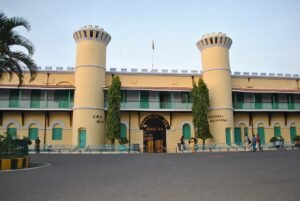 Image Credit:Jomesh – Own work, CC BY 3.0, Link Image Credit:Jomesh – Own work, CC BY 3.0, Link |
|---|---|
| Monument | Cellular Jail |
| Location | Andaman Islands |
| Explanation | The Cellular Jail, also known as “Kala Pani” meaning “was a colonial prison located in the Andaman and Nicobar Islands where British authorities exiled Indian freedom fighters and political prisoners during the independence movement. Today, the jail stands as a national memorial monument honoring the sacrifices made in the struggle for India’s freedom. Originally consisting of seven wings, the structure was heavily damaged in the 1941 earthquake. During World War II, two wings were dismantled by the Japanese to use the bricks for military structures. After independence, two more wings were removed in the 1950s to accommodate the Govind Ballabh Pant Hospital. Currently, only the watchtower and three wings remain intact. The Cellular Jail is recognized as one of the important monuments of India, symbolizing the country’s colonial history and fight for independence. |
| Image | 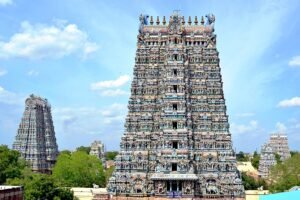 Image Credit: Mamichaelraj, CC BY-SA 4.0, via Wikimedia Commons Image Credit: Mamichaelraj, CC BY-SA 4.0, via Wikimedia Commons |
|---|---|
| Monument | Meenakshi Temple |
| Location | Madurai, Tamil Nadu |
| Explanation | A historic Hindu temple known for its towering gopurams and sculptures. The historic Arulmigu Meenakshi Sundareswarar Temple, also known as Arulmigu Meenakshi Amman Thirukkovil, is situated on the southern bank of the Vaigai River in Madurai, Tamil Nadu. The temple’s main sections, including the three-storeyed gopuram at the entrance to the Sundareswarar Shrine and the central part of the Goddess Meenakshi Shrine, were constructed by Pandyan Emperor Sadayavarman Kulasekaran I (reigned 1190–1205 CE). These portions are among the earliest surviving structures of the temple. and it is one of the important monuments of India symbolizing cultural significance. |
| Image | 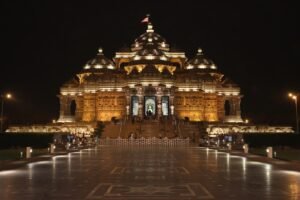 Image credit:<sonani, CC BY-SA 4.0, via Wikimedia Commons Image credit:<sonani, CC BY-SA 4.0, via Wikimedia Commons |
|---|---|
| Monument | Akshardham Temple |
| Location | Delhi |
| Explanation | A modern Hindu temple complex showcasing Indian culture and architecture. The temple is close to the border with Noida. Also known as Akshardham Temple or Akshardham Delhi, the complex displays traditional and modern Hindu culture and architecture. Inspired by Yogiji Maharaj and created by Pramukh Swami Maharaj, it was constructed by BAPS. It is the world's second-largest BAPS Hindu temple, following Akshardham, New Jersey, in the United States. |
| Image | 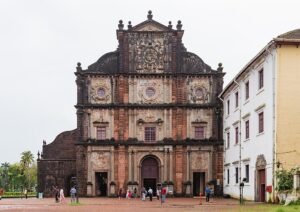 Image Credit: Mahesh – Own work, CC BY-SA 4.0, Link Image Credit: Mahesh – Own work, CC BY-SA 4.0, Link |
|---|---|
| Monument | Basilica of Bom Jesus |
| Location | Goa |
| Explanation | The Basilica of Bom Jesus, known as Basílica do Bom Jesus in Portuguese and Borea Jezuchi Bajilika in Konkani, is a Latin Church basilica situated in Goa's Konkan region, India. Located in Old Goa, the former capital of Portuguese India, it is a prominent pilgrimage site and a UNESCO World Heritage Site. It's protected under India's Ancient Monuments and Archaeological Sites and Remains (AMASR) Act (1958) and is managed by the Archaeological Survey of India. The basilica is famous for housing the mortal remains of St. Francis Xavier. Construction of the church commenced in 1594, and it was consecrated in May 1605 by Archbishop Dom Fr. Aleixo de Menezes. Recognized as one of the important monuments of India, the basilica holds a significant place in the history of Christianity. |
| Image | 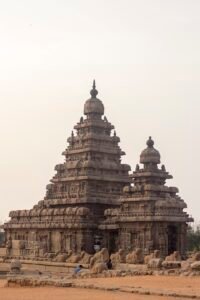
Image Credit: Murali Krishnan R, CC BY-SA 4.0, via Wikimedia Commons |
|---|---|
| Monument | Group of Monuments at Mahabalipuram |
| Location | Tamil Nadu |
| Explanation | The Group of Monuments at Mahabalipuram in Tamil Nadu, is UNESCO World Heritage Site and considered as a important monuments of india for its 7th–8th-century rock-cut cave shrines, monolithic ratha temples, structural temples and giant open-air bas-reliefs. The complex boasts about 40 ancient monuments and Hindu temples. |
| Image | 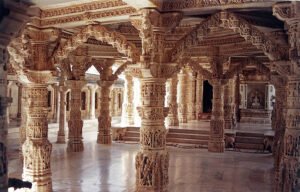 image Credits: Akshat patni, CC BY-SA 4.0, via Wikimedia Commons image Credits: Akshat patni, CC BY-SA 4.0, via Wikimedia Commons |
|---|---|
| Monument | Dilwara Temples |
| Location | Sirohi Distric, Rajashthan |
| Explanation | The Delwada (Dilwara) Jain Temples—about 2.5 km from Mount Abu in Rajasthan—comprise five marble shrines built between the 11th and 16th centuries. Renowned for their Solanki-style white-marble carving, these sacred Jain sites are not only a major pilgrimage centre but also rank among the finest monuments of India for any visitor interested in medieval craftsmanship and architecture. |
| Image | 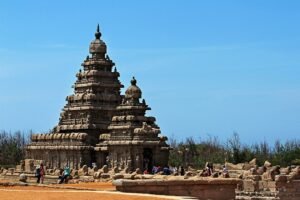 Image Credit:Swarna1311 – Own work, CC BY-SA 4.0, Link Image Credit:Swarna1311 – Own work, CC BY-SA 4.0, Link |
|---|---|
| Monument | Shore Temple |
| Location | Mahabalipuram, Tamil Nadu |
| Explanation | The Shore Temple, built around 725 AD, is a complex of temples and shrines situated along the Bay of Bengal in Mahabalipuram, approximately 60 kilometers south of Chennai, Tamil Nadu, India. Constructed with granite blocks in the 8th century, it was a thriving port under Narasimhavarman II of the Pallava dynasty. As part of the Group of Monuments at Mahabalipuram, it has been a UNESCO World Heritage Site since 1984 and is among the oldest stone-built temples in South India, earning its place among the most iconic monuments of India for both historical importance and coastal grandeur. |
India's vibrant history shines through its Monuments of India, from the majestic Taj Mahal to the serene Golden Temple and countless other architectural marvels. This guide to iconic landmarks captivates history enthusiasts and exam preparers, inviting a deeper exploration of India's rich cultural legacy.
Monuments of Assam – 30 Important MCQ
Kaziranga National Park | Explore Assam’s Incredible Wildlife | 2025
Top 50+ Important MCQ On Assam Geography | Quiz


